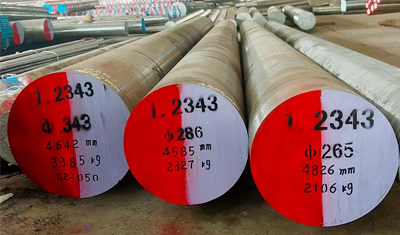Tel.: +86 714 3703 589 E-mail: [email protected]
Tool steels can be classified into six categories based on their chemical composition and different applications: water hardening, cold work, impact resistance, high speed, hot work, and special purpose. Cold work tool steels are tool steels used to deform or shape metal under cold conditions. It has high wear resistance, strength and toughness, bite resistance, softening ability at high temperature, etc. When working with cold work tool steels, their working parts are subjected to high pressure, bending forces, impact, and friction due to their large deformation resistance.
Therefore, failure of cold work tool steels is usually caused by wear as well as fracture, collapse forces, and deformation beyond the tolerance and prior failure. Cold working tool steel includes dying for cutting (blanking die, trimming die, punch, scissors), cold heading die and cold extrusion die, bending die and drawing die, etc.

Hot Work Tool Steels
Hot work tool steels are alloyed tool steels that retain their strength and hardness when subjected to high temperatures over long periods of time, such as hammer forging dies, hot extrusion dies, and die casting dies. Because hot dies are in direct contact with the molten iron, the requirements for strength, hardness, and thermal stability are more demanding, especially the high thermal strength, thermal fatigue, toughness, and wear resistance required to ensure a long enough die life. This is the main difference between the working conditions of cold molds. In addition, they differ from each other in the following ways. Next, the tool steel supplier will share it with you.
Cold work tool steels work at room temperature (below 100°C). Hot work tool steels are in contact with hot metal or even liquid metal, so the surface temperature of the tool is very high, usually 350 to 700°C.
Cold work tool steels usually have a high carbon content (1.45% to 2.30%) to meet the requirements of high hardenability and wear resistance. Sometimes medium carbon steels are used to improve the impact resistance and toughness of the tool. Cr (11% ~ 13%), Mo, W, V, and other alloying elements are added to cold work tool steels, mainly to improve hardenability and wear resistance.
Hot work tool steel is medium carbon (0.3% ~ 0.6%). It has higher requirements for red hardness, thermal conductivity, and wear resistance, and general requirements for hardness. alloying elements such as Cr, Mn, Si, Ni, W, Mo, V, etc. improve hardenability, oxidation resistance, wear-resistance, and red hardness.
Cold work tool steels are mainly used in the manufacture of drop dies (blanking dies, trimming dies, punches, scissors), cold head and cold extrusion die, bending dies, and drawing dies. Hot work tool steel is mainly used for die casting.
If you want to get more information about tool steel for sale, please contact us.